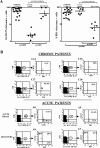Characterization of hepatitis B virus (HBV)-specific T-cell dysfunction in chronic HBV infection
- PMID: 17287266
- PMCID: PMC1866111
- DOI: 10.1128/JVI.02844-06
Characterization of hepatitis B virus (HBV)-specific T-cell dysfunction in chronic HBV infection
Abstract
Dysfunctional CD8+ T cells present in chronic virus infections can express programmed death 1 (PD-1) molecules, and the inhibition of the engagement of PD-1 with its ligand (PD-L1) has been reported to enhance the antiviral function of these T cells. We took advantage of the wide fluctuations in levels of viremia which are typical of chronic hepatitis B virus (HBV) infection to comprehensively analyze the impact of prolonged exposure to different virus quantities on virus-specific T-cell dysfunction and on its reversibility through the blocking of the PD-1/PD-L1 pathway. We confirm that chronic HBV infection has a profound effect on the HBV-specific T-cell repertoire. Despite the use of a comprehensive panel of peptides covering all HBV proteins, HBV-specific T cells were rarely observed directly ex vivo in samples from patients with chronic infection, in contrast to those from patients with acute HBV infection. In chronic HBV infection, virus-specific T cells were detected mainly in patients with lower levels of viremia. These HBV-specific CD8+ T cells expressed PD-1, and their function was improved by the blocking of PD-1/PD-L1 engagement. Thus, a broad spectrum of anti-HBV immunity is expressed by patients with chronic HBV infection and this spectrum is proportional to HBV replication levels and can be improved by blocking the PD-1/PD-L1 pathway. This information may be useful for the design of immunotherapeutic strategies to complement and optimize available antiviral therapies.
Figures






References
-
- Barber, D. L., E. J. Wherry, D. Masopust, B. Zhu, J. P. Allison, A. H. Sharpe, G. J. Freeman, and R. Ahmed. 2006. Restoring function in exhausted CD8 T cells during chronic viral infection. Nature 439:682-687. - PubMed
-
- Bengsch, B., H. C. Spangenberg, N. Kersting, C. Neumann-Haefelin, E. Panther, F. von Weizsacker, H. E. Blum, H. Pircher, and R. Thimme. 2007. Analysis of CD127 and KLRG1 expression on hepatitis C virus-specific CD8+ T cells reveals the existence of different memory T-cell subsets in the peripheral blood and liver. J. Virol. 81:945-953. - PMC - PubMed
-
- Bertoletti, A., C. Ferrari, F. Fiaccadori, A. Penna, R. Margolskee, H. J. Schlicht, P. Fowler, S. Guilhot, and F. V. Chisari. 1991. HLA class I-restricted human cytotoxic T cells recognize endogenously synthesized hepatitis B virus nucleocapsid antigen. Proc. Natl. Acad. Sci. USA 88:10445-10449. - PMC - PubMed
-
- Bertoletti, A., A. Costanzo, F. V. Chisari, M. Levrero, A. Artini, A. Sette, A. Penna, T. Giuberti, F. Fiaccadori, and C. Ferrari. 1994. Cytotoxic T lymphocyte response to a wild type hepatitis B virus epitope in patients chronically infected by variant viruses carrying substitutions within the epitope. J. Exp. Med. 180:933-943. - PMC - PubMed
-
- Boettler, T., E. Panther, B. Bengsch, N. Nazarova, H. C. Spangenberg, H. E. Blum, and R. Thimme. 2006. Expression of the interleukin-7 receptor alpha chain (CD127) on virus-specific CD8+ T cells identifies functionally and phenotypically defined memory T cells during acute resolving hepatitis B virus infection. J. Virol. 80:3532-3540. - PMC - PubMed
Publication types
MeSH terms
Substances
LinkOut - more resources
Full Text Sources
Other Literature Sources
Medical
Molecular Biology Databases
Research Materials

